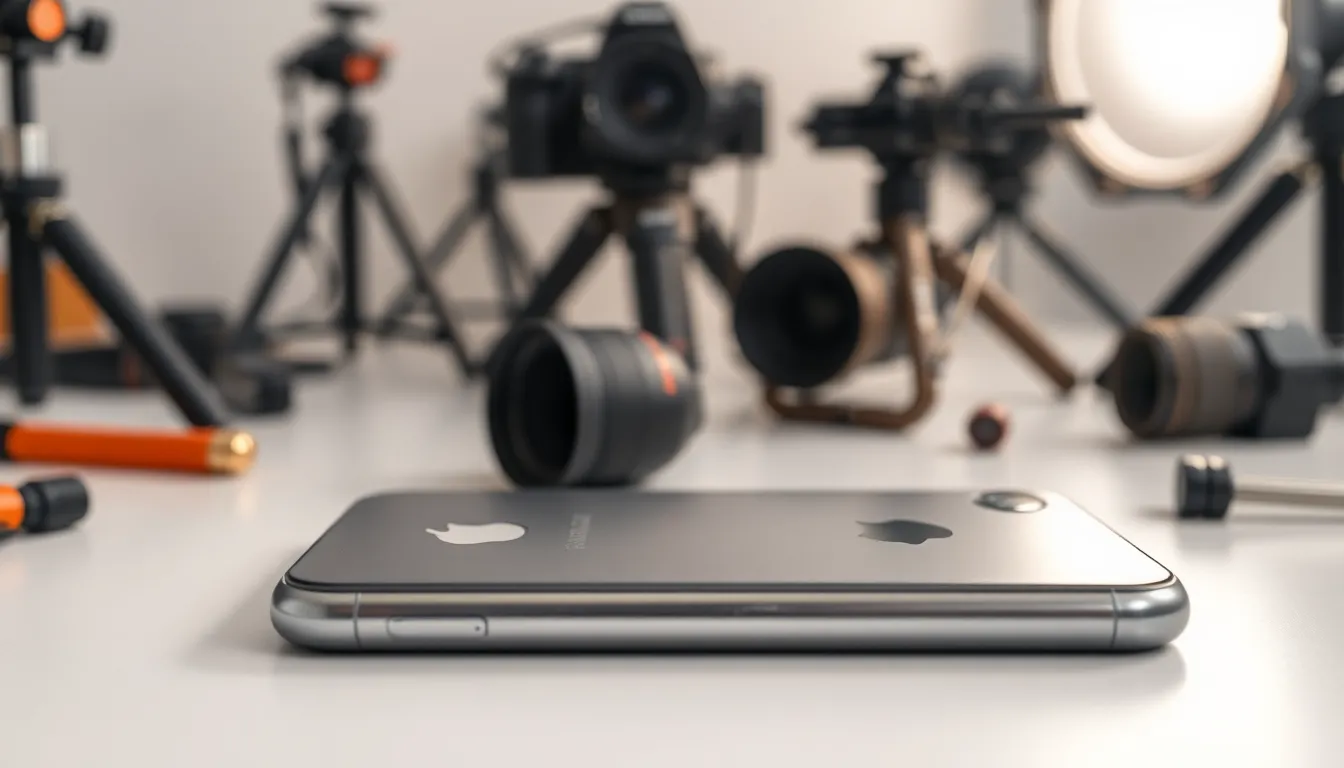Ever tried capturing that perfect sunset only to find your iPhone camera has decided to channel its inner Picasso? Instead of a stunning view, you’re left with an upside-down masterpiece that would baffle even the most seasoned art critic. It’s a puzzling scenario that leaves many scratching their heads and wondering if their phone’s been possessed by a mischievous spirit.
Table of Contents
ToggleUnderstanding the Issue
iPhone users often encounter the puzzling issue of photos appearing upside down. Understanding the underlying reasons helps troubleshoot this frustrating problem.
Common Causes of Upside Down Photos
Several factors lead to upside down photos. First, a miscalibrated gyroscope can affect image orientation. The gyroscope determines the device’s position, which impacts how photos are saved. Second, if the user rotates the phone manually or uses a third-party camera app, orientation discrepancies may occur. Third, software bugs in the operating system sometimes contribute to this issue as well. Ensuring the software is updated to the latest version often resolves these glitches. Furthermore, camera settings may need adjustments to restore proper functionality in image capture.
Impact of Orientation Lock
Orientation Lock can significantly alter how the camera captures images. When enabled, this feature prevents the screen from rotating along with the device. If the user forgets to disable Orientation Lock, photos taken while holding the phone at an unusual angle might appear upside down. This situation arises because the camera relies on the device’s orientation to save images correctly. Disabling Orientation Lock before capturing photos ensures images are consistently oriented, providing a straightforward solution to this common dilemma. Regular checks on lock settings can prevent future frustrations.
Technical Insights

Understanding the technical aspects of the iPhone camera can help users troubleshoot issues like photos appearing upside down. This section details the core functions and components that contribute to image orientation.
How the iPhone Camera Works
The iPhone camera utilizes advanced technology to capture images effectively. It relies on a combination of lenses, sensors, and software. When users take a picture, the camera processes data from the image sensor, interpreting color, light, and depth. This process includes orientation data from the device’s motion sensors. If the camera misinterprets this data, it can lead to photos appearing upside down.
Gyroscope and Sensor Functionality
The gyroscope plays a crucial role in maintaining proper orientation during photography. It detects the device’s position and movement, helping the camera adjust accordingly. When the gyroscope is miscalibrated, it can confuse the camera’s orientation detection. Users may notice that taking photos at an angle or rotating the device can affect image alignment. Additionally, other sensors, including the accelerometer, support the gyroscope by assisting with orientation data. Proper calibration of these sensors is essential for accurate image capture.
Troubleshooting Steps
Troubleshooting an upside-down camera can restore normal function quickly. Users can follow a few simple steps for a prompt solution.
Basic Fixes to Try
Start by checking if the Orientation Lock feature is enabled. Swiping down from the top-right corner opens the Control Center, where users can toggle this setting. Next, restart the iPhone to reset temporary glitches. Clearing the camera app’s cache might help as well, so closing the app and reopening it is beneficial. Additionally, switching between front and rear cameras provides a quick test of functionality. Users should always ensure that the iPhone’s software is updated since manufacturers often release patches for known issues.
Advanced Solutions
If basic fixes fail, performing a gyroscope calibration often resolves orientation problems. This process requires enabling the compass feature, which helps recalibrate the sensors. Users can access the compass through the Maps app, allowing them to follow on-screen prompts. For persistent issues, restoring the iPhone to factory settings is an option, but it’s essential to back up data beforehand. Lastly, reaching out to Apple Support ensures expert assistance available for complex problems.
Preventive Measures
Taking proactive steps can help avoid the frustration of an upside-down camera. Users can easily implement adjustments and maintenance techniques to ensure their iPhone’s camera functions correctly.
Adjusting Camera Settings
Configuring camera settings plays a vital role in maintaining proper image orientation. Users should verify that Orientation Lock is disabled before capturing images. Checking settings like Grid and HDR can enhance overall photography experience. Adjusting the camera’s format settings also proves beneficial for specific shooting scenarios. Users might also consider resetting all camera settings to restore optimal functionality, preventing misinterpretations of orientation data.
Regular Maintenance Tips
Regular maintenance helps sustain the iPhone’s overall performance. Updating to the latest software version addresses known bugs and improves stability. Restarting the device allows temporary issues to resolve, which may include camera-related problems. Cleaning the camera lens ensures clear images free of obstructions. Calibration of the gyroscope can also enhance accuracy in orientation detection, maintaining the integrity of image capture. Monitoring these aspects consistently leads to a better photography experience.
Experiencing upside-down photos can be frustrating for iPhone users. By understanding the various causes and implementing the troubleshooting steps outlined, users can restore their camera’s functionality. Keeping the software updated and regularly checking settings are essential for preventing future issues.
With a little attention to detail and proactive maintenance, capturing stunning images without the worry of orientation mishaps becomes a reality. If problems persist, seeking assistance from Apple Support can provide the necessary guidance to resolve more complex issues. Ultimately, a well-functioning camera enhances the photography experience, allowing users to focus on capturing beautiful moments.


